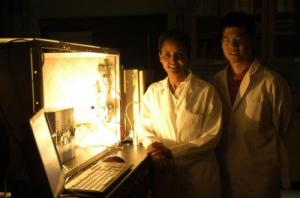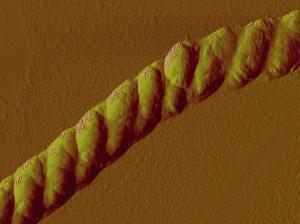Using a common metal most famously found in self-cleaning ovens, Sossina Haile hopes to change our energy future.
The metal is cerium oxide — or ceria — and it is the centerpiece of a promising new technology developed by Haile and her colleagues that concentrates solar energy and uses it to efficiently convert carbon dioxide and water into fuels.
Solar energy has long been touted as the solution to our energy woes, but while it is plentiful and free, it can’t be bottled up and transported from sunny locations to the drearier — but more energy-hungry — parts of the world. The process developed by Haile — a professor of materials science and chemical engineering at the California Institute of Technology (Caltech) — and her colleagues could make that possible.
The researchers designed and built a two-foot-tall prototype reactor that has a quartz window and a cavity that absorbs concentrated sunlight. The concentrator works “like the magnifying glass you used as a kid” to focus the sun’s rays, says Haile.
At the heart of the reactor is a cylindrical lining of ceria. Ceria — a metal oxide that is commonly embedded in the walls of self-cleaning ovens, where it catalyzes reactions that decompose food and other stuck-on gunk — propels the solar-driven reactions. The reactor takes advantage of ceria’s ability to “exhale” oxygen from its crystalline framework at very high temperatures and then “inhale” oxygen back in at lower temperatures.
“What is special about the material is that it doesn’t release all of the oxygen. That helps to leave the framework of the material intact as oxygen leaves,” Haile explains. “When we cool it back down, the material’s thermodynamically preferred state is to pull oxygen back into the structure.”
Specifically, the inhaled oxygen is stripped off of carbon dioxide (CO2) and/or water (H2O) gas molecules that are pumped into the reactor, producing carbon monoxide (CO) and/or hydrogen gas (H2). H2 can be used to fuel hydrogen fuel cells; CO, combined with H2, can be used to create synthetic gas, or “syngas,” which is the precursor to liquid hydrocarbon fuels. Adding other catalysts to the gas mixture, meanwhile, produces methane. And once the ceria is oxygenated to full capacity, it can be heated back up again, and the cycle can begin anew.
Related articles
- New solar fuel device that “mimics plant life” (news.bioscholar.com)
- Researchers develop reactor to make fuel from sunlight (guardian.co.uk)











